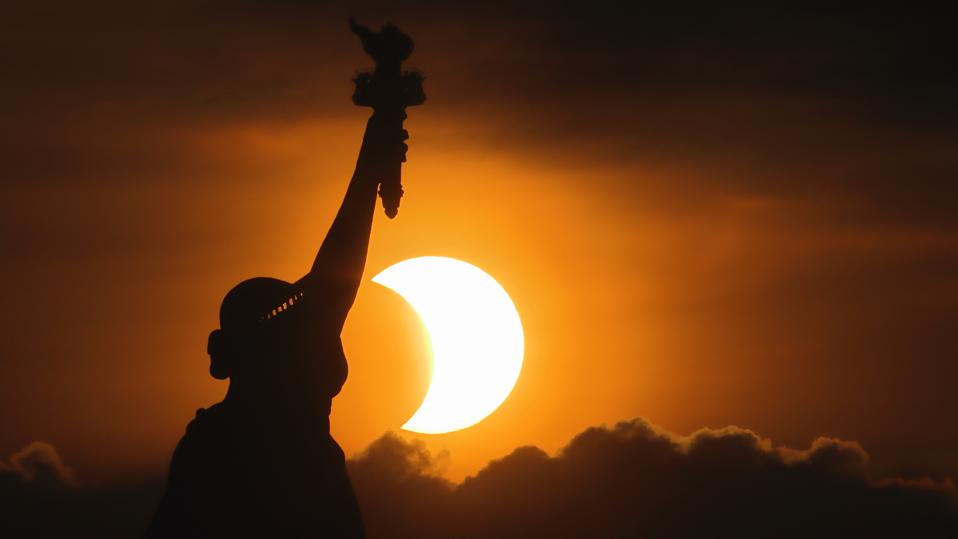Topline
Passengers can expect disruption to air travel during the total solar eclipse next month, the Federal Aviation Administration warned Thursday, urging pilots to prepare as states and businesses along its path brace for an influx of tourists hoping to catch a glimpse of the rare celestial phenomenon.
Key Facts
The total solar eclipse on April 8 could clog air traffic operating inside and near the path of totality, the FAA warned in a bulletin posted on its website.
For those located within the narrow strip of land affected by the phenomenon, the moon will completely block the sun, which leads to an abrupt transition from daylight to darkness to daylight again within a matter of minutes, the temperature drops and the star’s outer atmosphere, called a corona, is revealed in a fiery halo.
The FAA’s “special air traffic procedures” notice said the eclipse path will impact the U.S. from about 2:30 p.m. EDT to 3:40 p.m. EDT, though noted restrictions and changes to normal procedures can be expected up to five days ahead of the April 8 eclipse.
The agency said aircraft should prepare for rerouting and airborne holding for all domestic flights and urged aircraft departing airports along the eclipse path to coordinate departure times “as early as possible” to minimize congestion, adding that “special security provisions” may be put in place for the event.
Airports along the path of the eclipse are likely to have higher levels of traffic than normal and should “anticipate delays during peak” times, the FAA warned.
More than 100 airports were flagged as lying along the path of the eclipse—or close enough to it (within a 50 nautical miles margin either side)—with the potential to be affected, including Dallas-Fort Worth International, Cleveland Hopkins International Airport and Indianapolis International, Burlington International, Buffalo Niagara International and Syracuse Hancock International.
What To Watch For
A total of 15 states are in the path of the eclipse, according to NASA. It will enter the U.S. from Mexico, starting in Texas and travel through Oklahoma, Arkansas, Missouri, Illinois, Kentucky, Indiana, Ohio, Pennsylvania, New York, Vermont, New Hampshire, and Maine. With small parts also visible in Tennessee and Michigan. It will enter Canada and exit continental North America on the Atlantic coast of Newfoundland.
Tangent
Businesses and states lying along the path of the eclipse are expecting a boom of travel to view the event, which won’t be seen on the contiguous U.S. again until 2044. Delta Airlines is running flights along the eclipse’s path to allow people to spend “as much time as possible directly within the path of totality.” Indianapolis is reportedly the most-booked destination in North America for the event, according to Airbnb.
Big Number
31.6 million. That’s how many people live in the path of totality for the 2024 eclipse, NASA estimates. The agency said almost all Americans—99% of people in every contiguous stage plus parts of Hawaii and Alaska—will be able to see at least a partial eclipse from where they live.
Key Background
A solar eclipse happens when the moon passes between the sun and Earth and casts a shadow that fully or partially blocks the sun’s light. The nature of the eclipse will depend on where it is viewed from and only those at the center of the moon’s shadow will experience a total eclipse where the sun is completely obscured. The U.S. last experienced a total solar eclipse in 2017, though NASA notes its path was narrower and passed over fewer cities and densely populated areas than the 2024 one will. Barring limited exceptions, eclipses should not be viewed with the naked eye or gear not designed to protect eyes from the sun. Eye specialists warn doing so can be dangerous and lead to permanent and severe eye damage within seconds.

